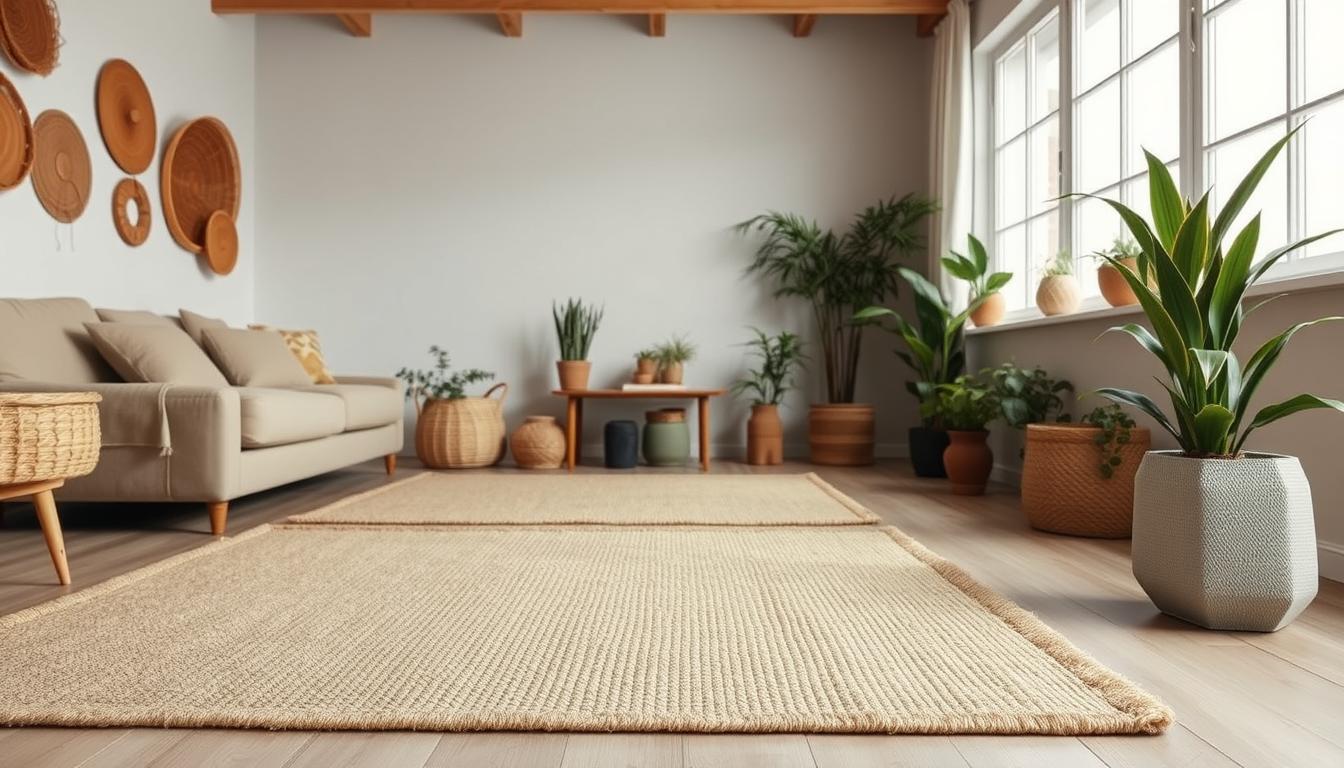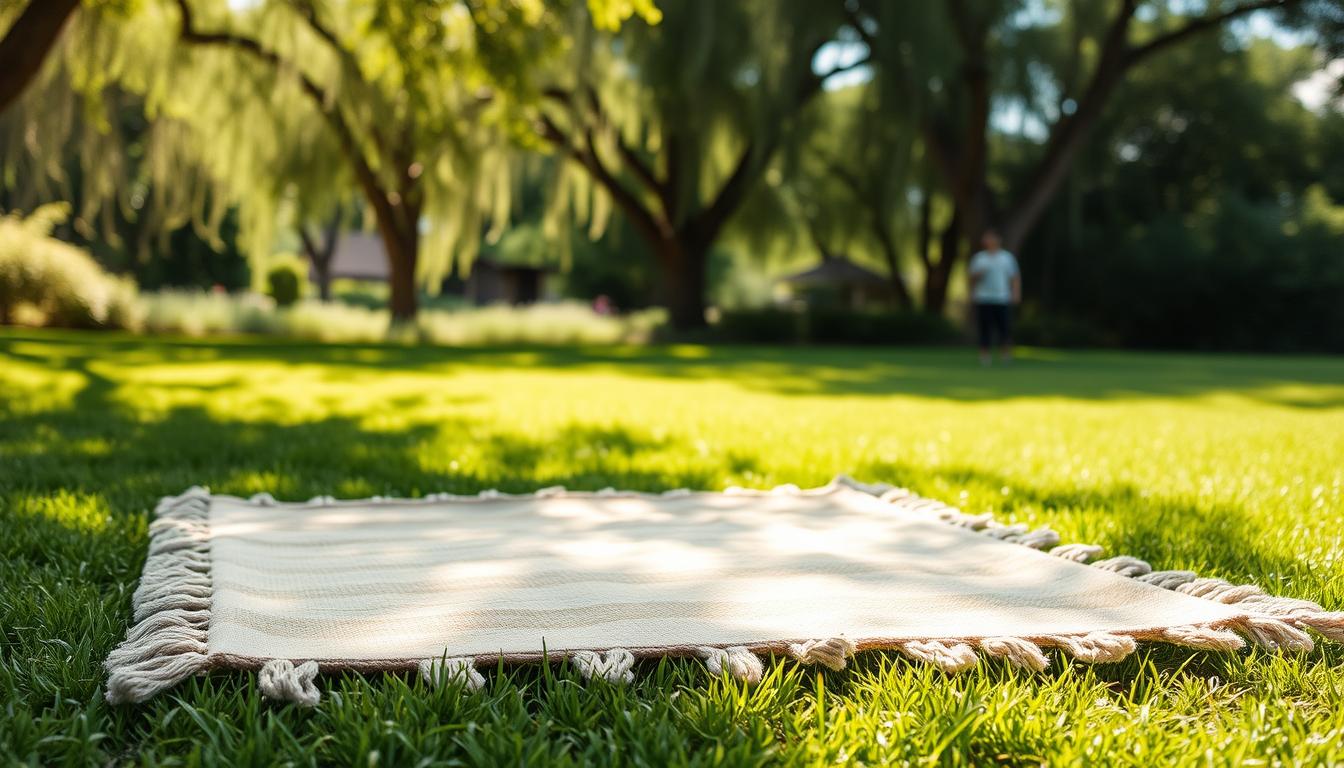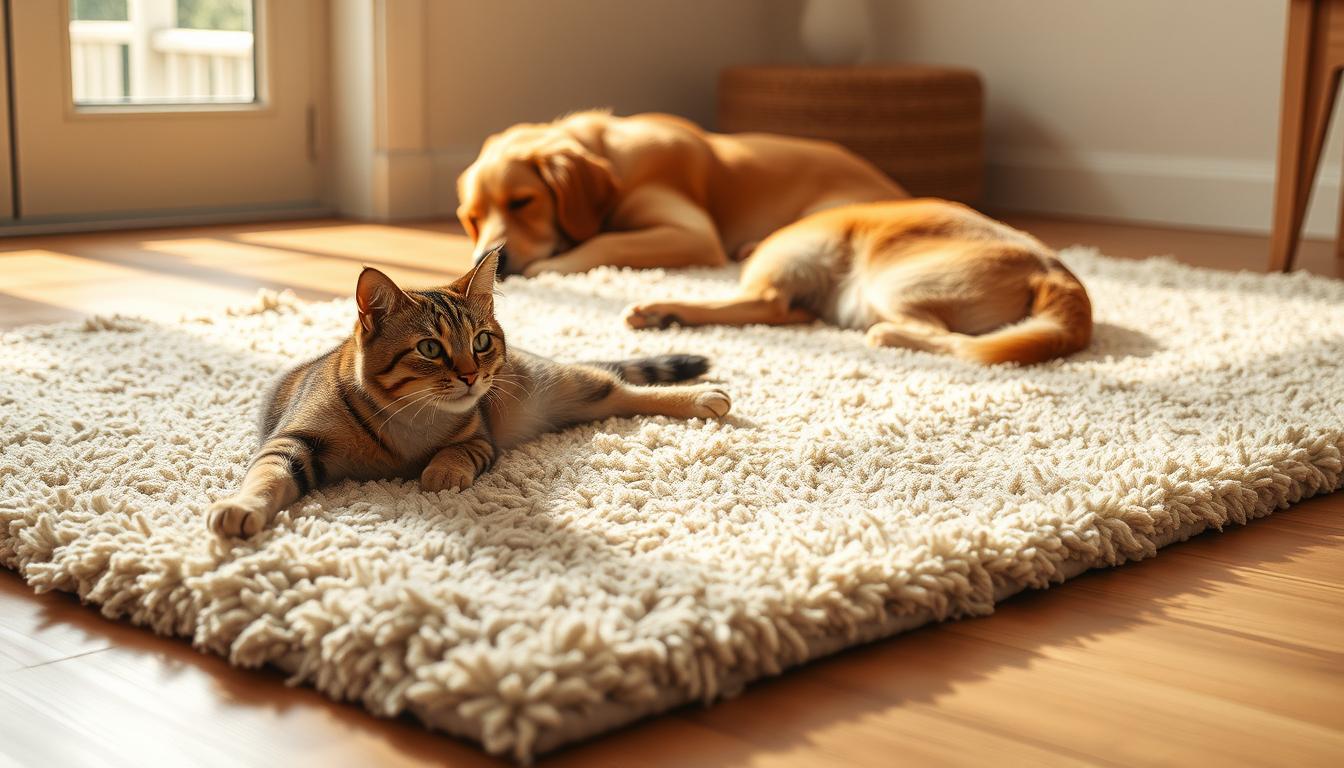
Cotton Rugs: 7 Pros and Cons to Consider
What if your dream rug isn’t as perfect as it seems? While lightweight floor coverings have surged in popularity for their casual charm, there’s more to these natural fiber pieces than meets the eye. Let’s unravel the truth behind their appeal—and limitations.

Machine-washable textiles transform messy spaces like kitchens into stress-free zones. Their breathable texture offers comfort underfoot, often at a friendlier price than premium wool alternatives. But here’s the catch: frequent foot traffic can wear down even the most vibrant patterns faster than you’d expect.
Design flexibility shines with dye-friendly materials, though many prefer earthy tones to amplify room dimensions. You’ll want to weigh factors like upkeep demands against your household’s rhythm. Are you ready to uncover which rooms benefit most—and where these fabrics fall short?
Key Takeaways
- Machine-washable fabrics simplify cleaning in active households
- Budget-friendly pricing competes with pricier natural materials
- Softer textures suit low-traffic relaxation spaces best
- Color retention varies based on dye methods and sun exposure
- Lifespan depends heavily on weaving density and foot traffic
Introduction to Cotton Rugs and Their Appeal
Your floors deserve materials that adapt to daily life effortlessly. Plant-based textiles bring a unique blend of practicality and style to active households, particularly in areas where spills and foot traffic demand easy-care solutions.
Earth-Friendly Foundations
Cotton’s renewable nature makes it a standout choice for eco-aware decorators. Unlike synthetic alternatives, these floor coverings decompose naturally while maintaining a gentle environmental footprint. Their breathable structure regulates room temperature, keeping hardwood floors from feeling clammy in humid months.
Comfort Meets Creativity
Walk barefoot across a hand-loomed piece, and you’ll immediately notice the cloud-like softness unique to this material. Designers love working with cotton’s dye-friendly surface, creating everything from bold geometrics to subtle ombré effects. Explore natural fiber options to find patterns that amplify your room’s dimensions without overwhelming them.
Affordability enhances cotton’s appeal—you can refresh your space seasonally without overspending. While vibrant hues may soften with sun exposure, this characteristic adds rustic charm to casual dining areas or sunlit reading nooks. Just rotate your rug periodically to maintain even color distribution.
Understanding Cotton as a Rug Material
Ever wonder how fluffy cotton bolls become floor-friendly textiles? The journey from field to living room reveals why this fabric dominates casual interiors. Farmers harvest mature cotton plants, then ginning machines separate fibers from seeds to create spinnable threads.
Unique Properties and Eco-Friendly Aspects
Cotton’s biodegradable nature sets it apart from plastic-based alternatives. Unlike synthetic materials, discarded pieces break down naturally without leaching microplastics. Artisans often use low-impact dyes, reducing chemical runoff during production.
Three factors make these floor coverings ideal for eco-conscious homes:
- Renewable sourcing: Plants regrow annually
- Energy-efficient processing: Requires less heat than wool treatment
- Non-toxic finishes: Safe for kids and pets
Breathability ranks among cotton’s standout features. Open-weave designs allow air circulation, preventing moisture buildup on hardwood floors. This makes them perfect for humid climates or rooms with temperature fluctuations.
Dye absorption varies by thread thickness, creating nuanced color patterns. Lighter hues enhance small spaces visually, while darker tones ground larger areas. Rotate pieces seasonally to maintain vibrant shades where sunlight hits hardest.
Manufacturers strengthen durability through tight weaving techniques. Flat-woven styles withstand moderate foot traffic better than plush piles. For high-use zones, look for double-stitched edges and reinforced corners.
Exploring the pros and cons of Cotton Rugs
Choosing floor coverings involves balancing softness with resilience. Natural textiles offer distinct advantages but come with trade-offs worth understanding before decorating your space.
Highlighting the Benefits
Effortless care stands out as a major perk. Many options survive washing machines, simplifying spill cleanup in busy kitchens or playrooms. Their lightweight design lets you shift layouts seasonally without straining your back.
Budget-conscious shoppers appreciate the price gap versus wool alternatives. You can layer multiple pieces for visual depth without overspending. Intricate patterns become focal points in spacious living areas, drawing eyes to handcrafted details.
Noting the Drawbacks
Longevity varies significantly based on construction quality. Flat-woven styles withstand moderate use better than plush piles, but neither matches wool’s decades-long endurance. High-traffic zones like entryways accelerate fraying along edges.
Sunlit rooms pose fading risks, though rotating pieces every six months helps. Blot spills immediately—natural fibers absorb liquids faster than synthetics. Consider these factors when selecting placements to maximize enjoyment while minimizing upkeep.
Key Benefits of Cotton Rugs
Imagine transforming your home’s busiest areas with floor coverings that simplify your routine. These natural fiber pieces deliver practical advantages that busy households truly appreciate.
Effortless Care for Active Lifestyles
Machine-washable convenience changes how you handle spills. Toss smaller pieces in your washer using cold water and mild detergent—no costly dry cleaning required. For stubborn stains, pretreat with baking soda paste before washing.

Air-dry flat to preserve shape and prevent shrinkage. This approach works wonders in kitchens where crumbs and splatters demand frequent refreshes. Unlike wool alternatives, you won’t stress about accidental wine spills during family movie nights.
Comfort That Adapts to Your Space
Walk barefoot across these textiles and experience cloud-like comfort unmatched by synthetic options. Their breathable structure feels cooler in summer yet cozy during winter months—perfect for playrooms where kids sprawl on floors.
Lightweight designs let you rearrange spaces effortlessly. Slide them under furniture for vacuuming or flip corners to refresh room layouts. This flexibility makes seasonal redecorating projects surprisingly manageable.
With proper care, these floor pieces maintain their inviting texture for years. Rotate them quarterly in sunlit rooms to prevent uneven fading. Their enduring softness becomes a cherished feature in bedrooms and reading nooks alike.
Limitations of Cotton Rugs in High-Traffic Areas
Does your hallway feel like a marathon route? Natural fiber floor coverings may not keep pace with constant activity. While perfect for cozy corners, these textiles face challenges where feet constantly tread.
Durability Challenges and Wear Over Time
Heavy foot traffic reshapes cotton fibers faster than sturdier materials. Flattened piles emerge along common walking paths, while edges fray from repeated friction. Threads loosen in doorways where shoes scrape surfaces daily.
Three signs signal replacement time:
- Visible color fading in walkways
- Thinning patches under furniture
- Unraveling seams at corners
Humidity worsens wear in busy zones. Moisture weakens fibers, making them prone to snapping. Rotate pieces monthly to distribute pressure evenly across the surface.
For entryways or playrooms, consider wool blends. Reserve natural fiber textiles for bedrooms or reading nooks. When edges curl persistently or patterns blur beyond recognition, it’s time for new floor protection.
Cotton Rugs in Various Living Spaces
Your home’s layout demands textiles that enhance both function and flair. Natural fiber floor coverings adapt beautifully to different zones, blending practicality with aesthetic flexibility. Let’s explore where these pieces shine brightest—and how to maximize their potential.

Strategic Placement Meets Design Vision
Kitchens benefit immensely from machine-washable options. Spills from morning coffee or pasta sauce wipe clean without drama. Bedrooms become sanctuaries with cloud-soft textures underfoot, especially in low-traffic retreats where comfort trumps heavy durability needs.
Children’s spaces thrive with these rugs. Sticky fingerprints? Toss them in the washer. Play areas stay inviting thanks to non-abrasive surfaces perfect for crawling toddlers. For larger rooms, bold geometric patterns anchor seating areas while letting other decor elements breathe.
Three style strategies elevate any space:
- Layer neutral tones in minimalist interiors
- Use vibrant hues to define conversation zones
- Mix textures with natural fiber pairings for depth
In humid climates, breathability prevents musty odors—a game-changer for sunrooms or screened porches. Rotate designs seasonally to refresh high-visibility areas without overhauling your entire decor scheme. Their lightweight construction makes rearrangement effortless when inspiration strikes.
Practical Care and Maintenance Tips
Keeping your floor coverings fresh requires smart routines. Machine-washable designs simplify upkeep, but proper techniques preserve colors and textures. Let’s break down strategies to tackle messes and extend your textile’s prime condition.
Effective Cleaning Techniques
Act fast when spills happen—blot liquids within 30 seconds. Use cold water and mild detergent for machine cycles to prevent dye bleeding. Check this table for optimal settings:
| Stain Type | Solution | Action Time |
|---|---|---|
| Food spills | Baking soda paste | Within 1 hour |
| Pet accidents | Enzyme cleaner | Immediate |
| Ink marks | Rubbing alcohol | Before drying |
Air-dry flat to avoid shrinkage. Never wring twisted fibers—reshape while damp. For stubborn spots, repeat treatments before washing.
Tips to Minimize Stains and Wear
Rotate pieces every 3 months in sunny rooms. Place doormats at entryways to reduce tracked-in dirt. Follow these steps to maintain vibrancy:
- Vacuum weekly with suction-only mode
- Avoid harsh chemicals that weaken fibers
- Store rolled—not folded—during off-seasons
High humidity? Use dehumidifiers near floor textiles. In dry climates, mist lightly to prevent brittleness. Proper care keeps your pieces looking new through countless cleanings.
Conclusion
Selecting home textiles involves more than just aesthetics—it’s about matching lifestyle demands. Natural fiber floor coverings strike a unique balance between softness and practicality. Their machine-washable convenience and budget-friendly pricing make them ideal for spaces needing frequent refreshes, like sunlit breakfast nooks or casual lounging areas.
Compare these textiles to wool counterparts when assessing longevity. While plush underfoot, they lack the dense fibers that withstand decades of stomping feet. Rotate placements seasonally to extend vibrancy in rooms with moderate activity.
Your final decision hinges on traffic patterns and design priorities. Layer multiple area rugs in low-use zones for textured depth without compromising durability. For entryways or playrooms, consider blending materials to merge comfort with resilience.
Weigh care requirements against your household’s rhythm. When maintained properly, these pieces become cherished elements in evolving interiors—softening footsteps while reflecting personal style through every thread.
FAQ
Are cotton rugs durable for daily use?
While cotton offers a soft, cozy feel, it’s less durable than wool or synthetic fibers. Over time, heavy foot traffic can cause fraying or flattening. They’re better suited for low- to medium-use spaces like bedrooms or casual lounging areas.
How do you clean spills on a cotton rug?
Blot spills immediately with a clean cloth and mild detergent mixed with water. Avoid harsh chemicals, as they can weaken natural fibers. For deeper stains, professional cleaning is recommended to preserve texture and color.
Are cotton rugs eco-friendly compared to synthetic options?
Yes! Cotton is biodegradable and renewable, making it a sustainable choice. Look for organic certifications like GOTS to ensure eco-friendly farming practices. Unlike polyester or nylon, it won’t shed microplastics.
Can cotton rugs handle moisture in bathrooms or kitchens?
Cotton absorbs water easily, which can lead to mold or mildew in damp areas. For bathrooms or kitchens, consider moisture-resistant materials like polypropylene or treated jute instead.
Do cotton rugs work well under furniture?
Their lightweight design makes them easy to shift, but heavy furniture can leave permanent indentations. Use rug pads to distribute weight and prevent slippage on hardwood or tile floors.
How does cotton compare to sisal or jute for a natural look?
Cotton offers a smoother, softer texture than sisal or jute, which have rougher weaves. It’s ideal for spaces where barefoot comfort matters, while sisal or jute adds rustic texture to high-traffic zones like entryways.
Will sunlight fade cotton rug colors over time?
Yes, prolonged UV exposure can dull vibrant dyes. Rotate your rug periodically and use curtains or blinds to protect it in sunlit rooms like living areas or sunrooms.









